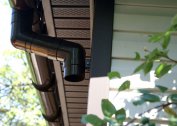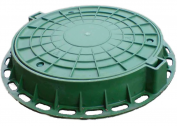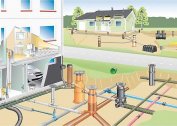The water located on the territory of the site, during freezing of the earth, leads to its expansion, while creating excessive pressure on the foundation of any structure - a cottage, a summer residence, an outbuilding. The gradual erosion by high located underground sources also negatively affects the fortress of the building. Drainage will protect the foundation of the house from destruction. A complex for collecting and draining water from a garden or summer cottage will protect the roots of plants from decay, prevent the appearance of stagnant puddles and waterlogging of the territory. If everything is done correctly, the drainage system will last more than half a century without repair.
Varieties of drainage systems
 When the drainage device uses several technologies:
When the drainage device uses several technologies:
- Indoor drainage. This is one of the easiest and most effective methods of dealing with excess soil moisture. It is carried out in the form of a system of trenches (one central with several branches), on the bottom of which a sand-gravel pillow is laid. The main moat is dug out at an angle to the spillway site. The total number of grooves and their size are determined depending on the abundance of moisture in the territory.
- Outdoor drainage. For its arrangement, they dig a ditch up to 70 cm deep and up to half a meter wide along the perimeter of the territory. For an unhindered flow of moisture into the trench of its side, it is made inclined at an angle of about 30 degrees. Water from the surface of the site is diverted to its edges. Imperfection of such drainage - the landscape deteriorates.
- Drainage trays. Usually they are made of concrete and installed at an angle of 2-3 degrees in the trenches, and a decorative lattice device is placed on top. At the bottom point, a spillway or a chamber for collecting liquid is arranged. Such a system is effective in terms of the discharge of water falling out with atmospheric precipitation, but is almost useless for deep subsoil sources.
The most convenient is considered a drainage option of pipes. It perfectly removes groundwater, especially lying close to the surface.
Pipe selection for drainage
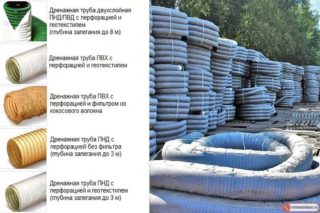 Pipes for the drainage line are intended to be divided into two types - for the catchment and for the removal of moisture. The collecting elements are provided with perforations through which water flows into the line. Communications of this type are mounted at an angle around the site or in the vicinity of buildings. Excess moisture is discharged to the drainage wells.
Pipes for the drainage line are intended to be divided into two types - for the catchment and for the removal of moisture. The collecting elements are provided with perforations through which water flows into the line. Communications of this type are mounted at an angle around the site or in the vicinity of buildings. Excess moisture is discharged to the drainage wells.
Products for water disposal do not have perforation. They are necessary for emptying drainage tanks. Drains are diverted to collector installations or specially equipped ditches. Drains can be installed in the soil to a depth of more than 10 m.
In addition, it is necessary to take into account a number of factors when selecting pipes.
Product Material
Pipe lines for creating drainage are made of the following materials:
- asbestos cement;
- ceramics;
- expanded clay and plastobeton;
- polymers.
The most popular pipeline parts are from high and low pressure polyethylene (LDPE or HDPE), as well as from polyvinyl chloride. On PVC pipes usually do not make perforations, they are used for water disposal.
Polyethylene elements are corrugated and equipped with moisture-absorbing perforations. They bend well, so they can be put on the territory with any relief.
Pipeline section
Products vary in size of section. Standard sizes are 110, 160, 200 mm. For complexes with a significant load, pipe segments are made and with a large diameter up to 300 mm.
For a small area with low groundwater, products with a minimum cross section can be used.When installing a drainage line with an abundance of branches, even on a small area, it will be necessary to apply pipe segments of different diameters.
You can also lay flat drainage pipes that are not inferior in effectiveness to round counterparts. They are made with perforation and in a sheath of geotextiles. Flat lines are strong in compression, so the system can be installed at the surface.
Soil type
 Perforated pipe sections are laid in the ground with a lot of gravel, but without a filter made of geo-fabric. In sandy soils, perforated pipes wrapped with geomaterial are used. It will be necessary to fill them with gravel to prevent damage to the highway.
Perforated pipe sections are laid in the ground with a lot of gravel, but without a filter made of geo-fabric. In sandy soils, perforated pipes wrapped with geomaterial are used. It will be necessary to fill them with gravel to prevent damage to the highway.
Perforated pipe sections with a filtering coil of coconut fiber or geomaterial are installed in alumina. Be sure to fill in gravel, covering the highway by 15–20 cm.
For loam, perforated highways wrapped in geo-fabric are used.
In any land, the use of conventional sewer pipes with independently made holes or cuts and a winding of geo-fabric is also allowed. This will significantly reduce the cost of installing drainage.
Design work
 The independent installation of the drainage line is started with the determination of the installation location. Location is possible in one of two options:
The independent installation of the drainage line is started with the determination of the installation location. Location is possible in one of two options:
- “Wall” drainage complex around the perimeter of the foundation foundation of a private house, protecting it from the ingress of water inside;
- drainage line around the perimeter or throughout the personal territory - makes it possible to protect the basement of the building, all outbuildings and garden crops.
Much attention is paid to the relief of the site. The pipeline must be mounted so that nothing interferes with the outflow of moisture into the ditches.
If geodetic studies have not been carried out, you will need to independently draw up a diagram, with marks on it of places where rainwater flows.
Before installation, it is necessary to form a project with a drawing in scale. This allows you to determine the number, diameter and stiffness of the pipes required for the drainage device. In this case, the distance between the pipelines is taken into account. It is determined based on the amount of moisture in the area: the more it is, the closer the lines are installed. At what depth you can dig a drainage pipe depends on the occurrence of groundwater, but not less than 50 centimeters.
In the completed drawing, it is also marked out where to install the water collectors. You will need to determine the mounting points of the inspection wells to check and eliminate possible blockages. They are installed on the corners of the system.
Tools and materials
To equip a drainage pipeline with your own hands, you will need:
- shovels (shovels and bayonet);
- manual device for tamping sand and gravel pillows;
- garden wheelbarrow for soil removal;
- pipe cutter;
- electric drill or grinder, if you need to make notches (perforations);
- scissors for geotissue.
In addition, you need to prepare building materials: pipes and fittings, adapters for inspection hatches and a collector, gravel or gravel, sand. If the pipes are delivered without cases made of filter material, a rolled geotextile will be required. Revision wells can be bought ready-made or assembled from plastic tanks, pipes with a section of 300-500 mm.
Installation Steps
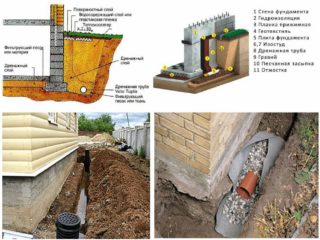 Before laying pipes, it is required to prepare grooves for them. To do this, dig trenches, put a 15 cm layer of sand and 20 cm of crushed stone at the bottom. The position and depth of the highway are determined in strict accordance with the created project.
Before laying pipes, it is required to prepare grooves for them. To do this, dig trenches, put a 15 cm layer of sand and 20 cm of crushed stone at the bottom. The position and depth of the highway are determined in strict accordance with the created project.
Laying a drainage pipe to collect and drain water from the site - step by step instructions:
- Cut the pipes of the required length and connect them together according to the scheme.
- Lay the drain pipe in a ditch on a pillow of sand and gravel - this can be done with your own hands, without involving special equipment. Plastic pipes are very light.It is necessary to lay the pipeline at a slope of at least 3 degrees. For proper installation, calculate the depth of the beginning of the pipe and its end depending on the required angle of inclination. Be guided in laying the trunk on a cord stretched over the pegs from these points. To create the desired slope of the pipeline, use special gaskets.
- Install the inspection wells in places of sharp turns and sudden elevations. They are necessary for maintenance and cleaning of the entire line.
- Connect to the reset site. It can be a sewage system, a city drainage system or a nearby body of water. If this is not possible, at the lowest point, set up a camera for storage. When filling, water is pumped out of it.
After laying the drainage line, you can dig trenches. To begin with, a layer of rubble is poured, and then a layer of sand.
The cost of laying drainage pipes
To get a running meter of tubular elements with perforation holes with a cross section of 110 mm in a filter made of geotextiles, on average you need to spend 55 rubles, with a diameter of 160 mm - 110 rubles, 200 mm - 185 rubles. For flat products, the price starts at 75 rubles. Non-perforated options cost less - from 12 rubles per square meter.
It is necessary to include in the estimate the cost of connecting parts, inspection wells.
If you hire professionals, arranging the drainage will be more expensive. The price of turnkey installation of a drainage pipe per linear meter is from 1300 rubles.
Common styling errors
 Poor operation of the system can be triggered by such factors:
Poor operation of the system can be triggered by such factors:
- Incorrect trench depth. Such a mistake can cause water imbalance, which will lead to stagnation of water in the territory, the appearance of ice plugs during freezing. If the highway is located above groundwater, they simply will not be able to get into the pipe.
- Pipelines are located at a great distance from each other. Drains are mounted with a distance of not more than 10 m for clay areas and 50 m for sand.
- Not made bias. If the pipeline is mounted in a strictly horizontal direction and there is no slope to the drainage system, moisture will become stagnant in the pipes.
- Installed a lot of revision hatches. The distance between the manholes should normally be 50 m or more, if they are closer, they will interfere with the drainage.
One of the common mistakes is an attempt to reduce costs by using pipe sections for drainage that do not fit the design. Such savings lead to malfunctions and significantly reduce the operational life of the line. This relates both to the diameter of the pipes and to the material from which they are made.
If you properly operate and maintain the drainage complex, it will last a long time. Every four years, a system inspection is required; every two years, the moisture level in the inspection wells is measured.
